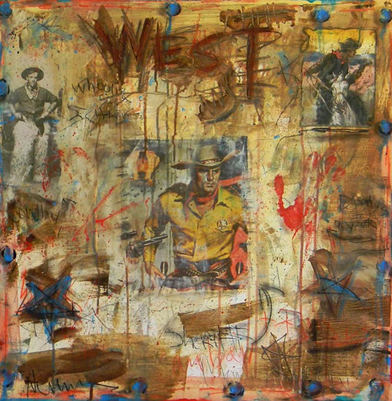
Marketing people love to talk about brands. It’s easy to see that branding is important to large corporations, but did you know that you can implement branding principles that will help you sell more of your art? So what is branding? Entrepeneur.com defines branding as:
Simply put, your brand is your promise to your customer. It tells them what they can expect from your products and services, and it differentiates your offering from that of your competitors. Your brand is derived from who you are, who you want to be and who people perceive you to be. (www.entrepreneur.com)
People often confuse the word “brand” with the word “logo”. From the definition above, you can see that a brand is far more than just a logo. In fact, a logo is just a small tool that helps you convey your brand to your customers.
So how do you create your brand, and how do you project that brand to your clientele? Let’s look at five important steps in the branding process.
If branding is the process of conveying your promise to your customers, it’s a good idea to know who your customers are and what they need. The better you understand your customers, the better you will be able to deliver on your promise to them.

Knowing your customers will also help you recognize future potential buyers who share similar traits. It’s a mistake to think you can sell your art to anyone and everyone. The truth is that within the broader market, there is a niche of people who are going to be interested in your work and who are going to be able to purchase it. The more you know about this niche, the better you will be able to target it.
Does your artwork appeal to buyers of a certain age? Do your buyers tend to come from a certain professional background? Do your buyers share common interests or hobbies?
So how do you get to know all of this information? By building relationships with your customers. If you are selling directly to your clientele at art shows or open studio events, I would encourage you to work toward building lasting relationships with your buyers, not just selling to them once. Building relationships takes time and care, but if you can demonstrate genuine interest in your clients, you will be well on your way. If you haven’t read Dale Carnegie’s book, How to Win Friends and Influence People (or if it’s been a while) I highly recommend it. The book is a classic, but the principles are just as true today as they were when the book was written over 60 years ago.
If you are showing your work through galleries, it can be more difficult to get to know your clients since the gallery sits between you and the customer. Show receptions are a great opportunity to get to know your customers, but you could also encourage the galleries you work with to set up private lunches or dinners with clients (with the gallery owner or director present, of course).
You can also survey your past clients to get a better sense of who they are and what they like about your work. TechRepublic.com wrote a great step-by-step guide for using Google forms to create a survey, which you could send out to your mailing list.
Of course, knowing your customer is only part of the battle. You also need to know what you have to offer that is unique. The art market is a very competitive place and there are many, many artists out there vying for attention. How can you possibly stand out in such a crowded market place?
I would suggest that it’s important to think of your motivation instead of your product (your artwork). If you are a painter of impressionistic landscapes, you are one of tens of thousands of impressionistic landscape painters. Let’s face it, it’s going to be hard to find something unique in the work that sets it apart from the competition. What is unique, however, is the path that brought you to create your art. The particular combination of your life experiences, your passion and your approach to your art make you unique. In other words, the branding is about you more than it is about the art. The better you understand yourself and your passion and where your artwork is coming from, the better you are going to be able to build a successful brand as an artist.
I’ve written frequently on the importance of consistency. Creating consistent work has its own rewards, but it also plays a huge roll in your brand. If you know what your interests and motivation are, and you strive to create work that is in keeping with your passion, consistency should come naturally. Some artists have to work through a number of different styles and subjects to figure out where their passion lies. The end goal should be to find a style that can sustain your creative energy over the long run.
Certainly your work will evolve over time, and your passion may lead you in different directions, but those changes should come over the course of years or even decades. You shouldn’t be completely reinventing yourself every couple of months.
Think of the great artists in history – Picasso, Monet, Georgia O’Keeffe, Rodin, Pollock, etc. – each created a distinctive look and stuck to it. As I said, these artists’ styles evolved over time, but not so radically that you couldn’t recognize the underpinnings of the artist’s voice.
Once you have begun to discover your voice and your motivations, strive to create design that matches your brand. Your logo, website, business cards, brochures, emails and other printed materials should all consistently convey the message about who you are. An experienced graphic designer will be able to help you capture your brand for your materials.
Examples
A couple of examples will help illustrate how design can reflect an artist’s brand:
Dave Newman – a Xanadu Gallery represented artist has a background in graphics and has done a great job of creating a visual language on his website that fits his work perfectly. You can visit Dave’s site at www.davenewmanstudio.com/ to see what I mean.
Above: Dave Newman’s collage “Blood is on Your Hands” and the banner from his website with links.
Conceptual artist Tauba Auerbach’s website looks like abstract squiggles and lines, until you realize the artist has created a quasi-hieroglyphic typeface that matches artist’s work. Experience the website.
Above: Home page for Tauba Auerbach’s website and the sculptural piece “Helix”
Your site doesn’t have to be quite as custom or radical as these sites, but it should be in keeping with your brand.
Your brand can’t exist in a vacuum. While you can put a lot of thought and effort into creating a brand, until you put yourself and your work out in front of collectors, it’s all theory. Those who experience your work may be able to tell you more about your work than you can. Ask people, “What do you find to be unique about my work?” and “What first drew you to my art?”
Showing your work in art shows and festivals or open studios can be a great way to get your feet wet in the market and to build your brand awareness. Showing in galleries will help you further solidify your brand.
Want a quick jump start to developing branding around yourself and your work? Answer the questions below – I would encourage you to write out your responses. Your answers will be a good start towards building a stronger brand.
- How would you respond to someone who asks you, “What kind of art do you do?”
- Once you’ve answered that question, how would you answer the follow-up question “Why do you do that kind of art?”
- What words do your clients commonly use to describe your work?
Have you worked to develop your brand? How has it helped your art business? What do you plan to do to further develop your brand? Do you know of artists who have done a good job of creating brands (share their website address)? Please share your thoughts and experience in the comments section below.

